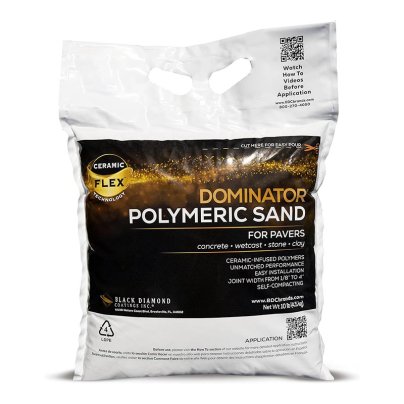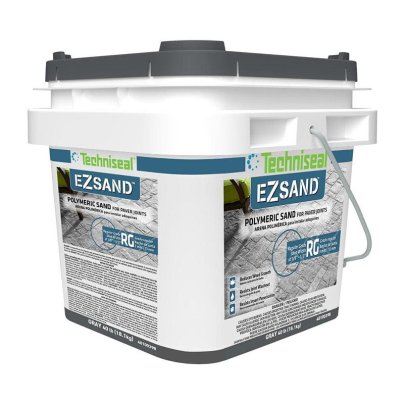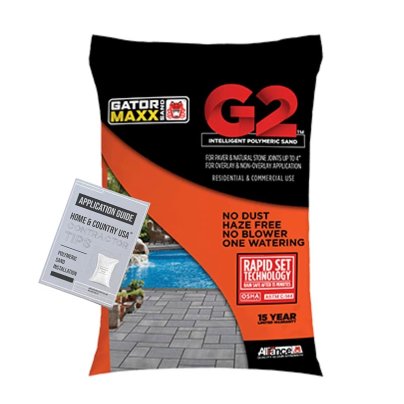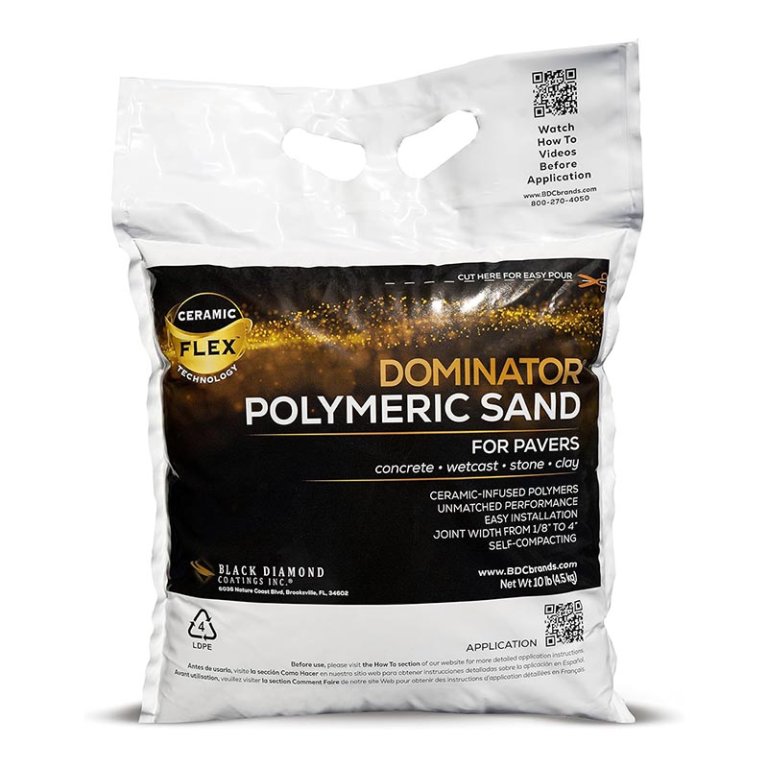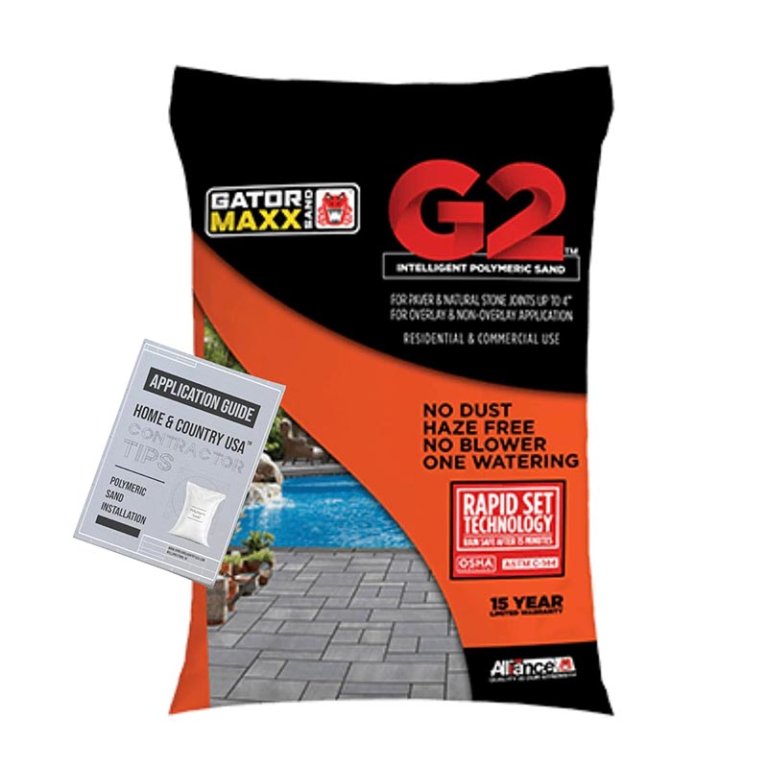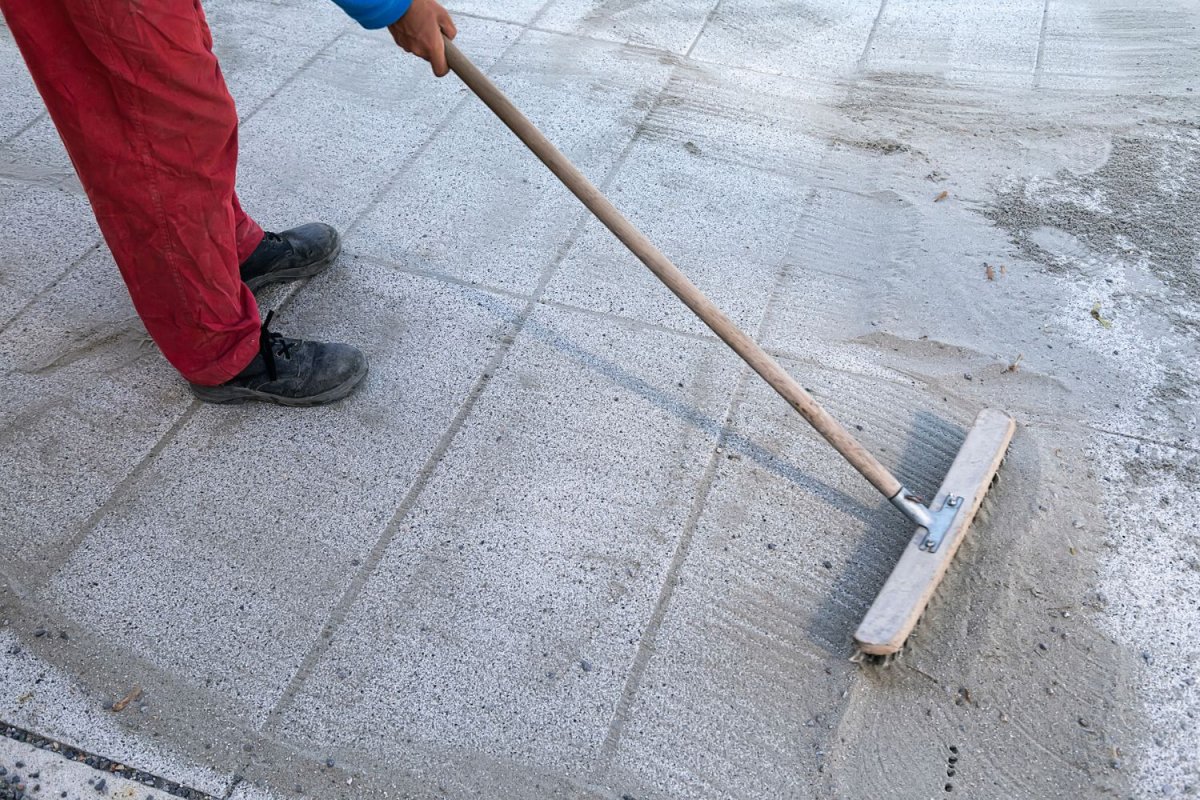
We may earn revenue from the products available on this page and participate in affiliate programs. Learn More ›
When it comes to beautiful hardscapes like patios, driveways, and walkways, it’s hard to beat the high-end look of pavers—especially when the joints are filled with polymeric sand. Not only does polymeric sand create a clean finished look, it also keeps pavers in place and helps prevent weeds and grass from growing up through the cracks.
Sometimes called jointing sand, paver sand, or hardscape sand, polymeric sand is not the same as regular sand. Instead, it’s coated with a water-activated polymer that causes the grains to stick together when dampened to produce a seal that looks like grout but that makes a stronger joint. After researching a range of polymeric sand products on the market and reaching out to an expert for advice, we selected the Black Diamond Coatings Dominator Polymeric Sand as our top pick for long-lasting paver installation. Below, find the rest of our picks for the best polymeric sand in a range of categories.
- BEST OVERALL: Black Diamond Coatings Dominator Polymeric Sand
↓ Jump to Review - BEST BANG FOR THE BUCK: Techniseal EZSand Polymeric Paver Sand
↓ Jump to Review - UPGRADE PICK: Alliance Gator Maxx G2 Intelligent Polymeric Sand
↓ Jump to Review - BEST MOISTURE-RESISTANT: Rhino Power Bond Plus Polymeric Sand
↓ Jump to Review - ALSO CONSIDER: BuddingCo Polymeric Sand
↓ Jump to Review
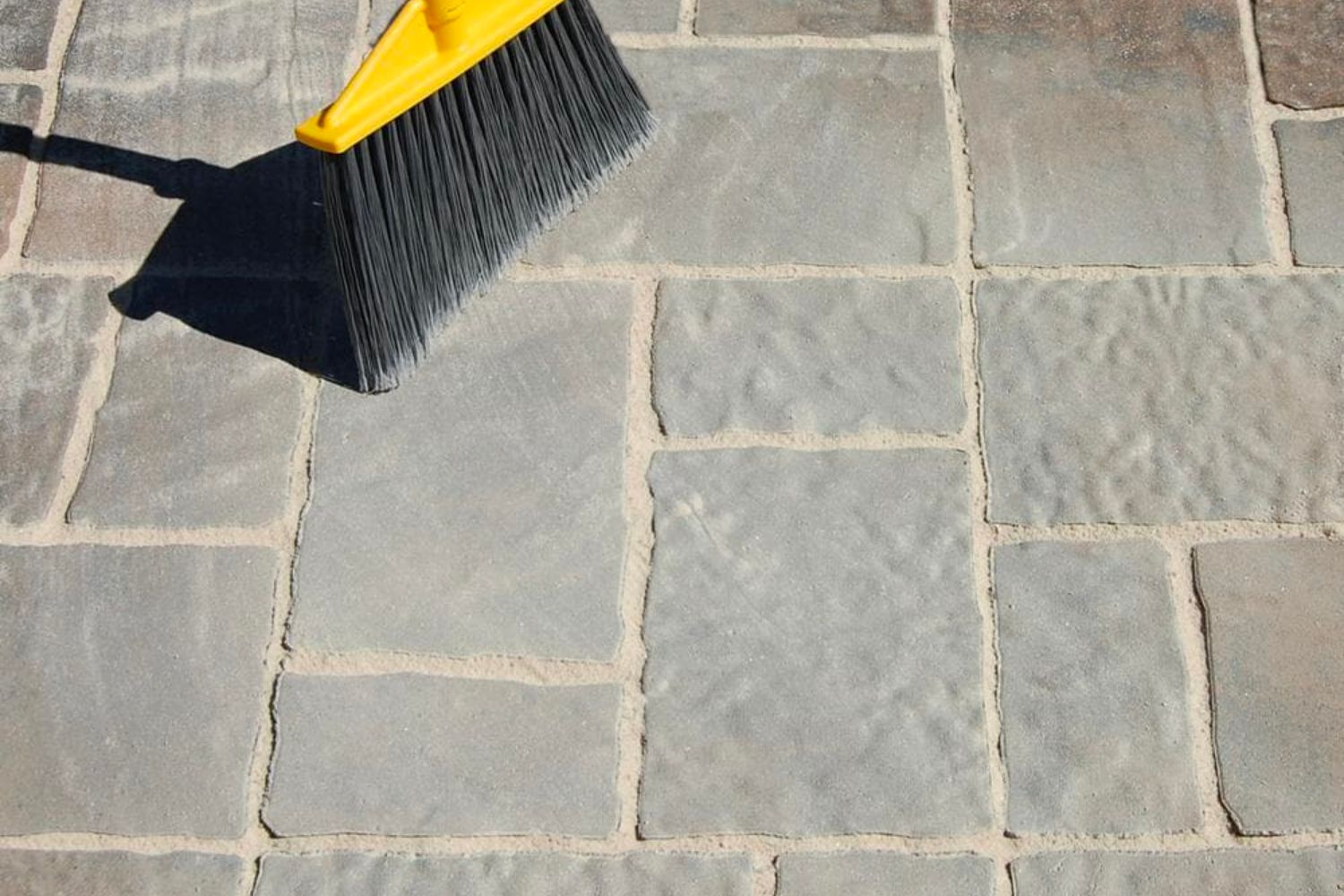
Polymeric Sands Comparison
| Product | Quantity | Working Temperature | Multiple Colors |
|---|---|---|---|
| Black Diamond Coatings Dominator Polymeric Sand | 10 or 40 pounds | 50 degrees Fahrenheit or above | Yes |
| Techniseal EZSand Polymeric Paver Sand | 40 pounds | 32 degrees Fahrenheit or above | No |
| Alliance Gator Maxx G2 Intelligent Polymeric Sand | 50 pounds | 32 degrees Fahrenheit or above | Yes |
| Rhino Power Bond Plus Polymeric Sand | 10, 20, or 50 pounds | 32 degrees Fahrenheit or above | Yes |
| BuddingCo Polymeric Sand | 18 pounds | 32 degrees Fahrenheit or above | No |
Our Top Picks
Here are picks for some of the best polymeric sands in a range of categories. Read on for in-depth shopping considerations.
Best Overall
Photo: AmazonWhat We Like
- Enough color options to match almost every project surface
- Available in 10- or 40-pound containers
- Self-healing, keeping insects and weeds away
What We Don’t Like
- Color match between bags can vary
Specs
- Quantity: 10 or 40 pounds
- Working temperature: 50 degrees Fahrenheit or above
- Multiple colors: Yes
Whether shoppers are building a paver patio or an entire stone driveway, Black Diamond Coatings’ joint stabilizing polymeric sand provides the quality and color options to help complete the task. It’s available in options like midnight black, camel brown, charcoal gray, gray beige, natural ivory, and titanium gray in both 10- and 40-pound containers.
Since polymeric sand coverage depends on the width and depth of the joints, the manufacturer includes a helpful calculator tool on its website to help determine how much you’ll need for your space. This sand for paver joints features the company’s Solid-Flex formula, which is made from fine sand and is free of cement. The formula allows the sand to flex while remaining durable and water-resistant. Should any cracks appear, Solid-Flex self-heals, keeping ants, grass, weeds, and other paver busters from taking advantage.
Get the Black Diamond Coatings polymeric sand (various sizes) at Amazon or The Home Depot.
Best Bang for the Buck
Techniseal EZSand Polymeric Paver Sand
Buy at The Home DepotWhat We Like
- Resists erosion, insects, and weeds
- Affordable compared to higher performance options
- Very easy to use and produces little to no hazing when used correctly
What We Don’t Like
- Not suited for heavily trafficked areas
Specs
- Quantity: 40 pounds
- Working temperature: 32 degrees Fahrenheit or above
- Multiple colors: No
Paver projects can be pricey, no matter if you’re planning a creative driveway project or a simple natural stone path. To bring down costs a bit, you might want to consider this paver locking sand from Techniseal. A 40-pound bucket of sand provides up to 55 square feet of coverage for the ½-inch wide joints common on interlocking pavers. Once installed, it can also help inhibit weed growth and deter ants and other insects.
While more affordable than higher-performance polymeric sands, Techniseal EZSand is designed for lighter-duty residential environments and may not withstand the heavy traffic of commercial settings.
Get the Techniseal polymeric sand at The Home Depot.
Upgrade Pick
Photo: AmazonWhat We Like
- Provides professional-level results
- Suitable for use with all paver surfaces
- Easy to use and does not cause any hazing issues
What We Don’t Like
- Only available in 50-pound bags
Specs
- Quantity: 50 pounds
- Working temperature: 32 degrees Fahrenheit or above
- Multiple colors: Yes
Alliance Gator Maxx G2 intelligent polymeric sand is a brand pros trust, but with its easy installation process, it works just as well for DIYers. This 50-pound bag of polymeric sand covers up to 85 square feet. It works on tight joints as well as wider joints up to 4 inches. This polymeric sand for pavers comes in beige, slate gray, ivory, and black diamond.
The G2 hardening sand for pavers features a no-dust, haze-free formula that’s strong and durable. It’s also rain-safe in as little as 15 minutes, allowing you to apply it to a patio, walkway, or driveway on less-than-ideal days.
Get the Alliance polymeric sand at Amazon or Walmart.
Best Moisture-Resistant
Photo: AmazonWhat We Like
- Suitable for joints up to 4 inches
- Haze-free formula is rainfast in an hour
- Versatile enough for pool decks, patios, walkways, and driveways
What We Don’t Like
- Can wash away if not applied correctly
Specs
- Quantity: 10, 20, or 50 pounds
- Working temperature: 32 degrees Fahrenheit and above
- Multiple colors: Yes
Rhino Power Bond Plus polymeric sand for flagstone, concrete, clay, and natural stone pavers is a high-performance pick for joints up to 4 inches wide. It sets to rainfast in an hour and uses a haze-free formula that prevents cloudy residue on patio pavers. It’s also engineered to withstand harsh weather, including rain, snow, and intense sun, providing long-term durability for patios, driveways, paths, and pool surrounds.
Available in multiple colors, you should be able to find the right shade of Rhino Power Bond Plus for your hardscape designs. Just be sure all surfaces are completely dry for installation, as improper application can lead to poor bonding. As with any paver joint compound or concrete crack filler, coverage per bag varies with joint width, so larger projects may require more than one bag. Since this pick comes in three sizes, though, you should be able to get pretty close in terms of buying an appropriate amount.
Get the Rhino polymeric sand (various sizes) at Amazon, Walmart, or Rhino.
Also Consider
BuddingCo Polymeric Sand
Buy at AmazonWhat We Like
- Ideal for colder climates
- Offers coverage of up to 40 square feet
- Easy to apply with a sweeper or poured
What We Don’t Like
- Can wash out with heavy rainfall
Specs
- Quantity: 18 pounds
- Working temperature: 32 degrees Fahrenheit or above
- Multiple colors: No
BuddingCo’s polymeric sand is worth considering for any paver installation, including patios, walkways, driveways, stone pathways, and parking spaces. One bucket of this polymeric sand can provide up to 40 square feet of coverage, depending on joint width.
BuddingCo’s formula is suitable for joints up to 1 inch, which is about average for polymeric sand. However, it’s able to set in temperatures as low as 32 degrees Fahrenheit, which allows users to get a jump on some of their outdoor projects in the early seasons or seal driveways in the winter.
Get the BuddingCo polymeric sand at Amazon.
Jump to Our Top Picks
How We Chose the Best Polymeric Sands
To provide a comprehensive list of reliable poly sand options, we researched a range of popular products and consulted professionals to get their opinions on what matters most when choosing paver sand.
According to Roger Van Alst, the owner and president of Black Diamond Paver Stones & Landscape, it’s smart to think about intended use when selecting paver sand. “Just make sure you are picking the correct sand for the application,” he says. “The bags and manufacturers do a good job of indicating the proper uses for each type.” With this in mind, our top picks include options suitable for varying gap sizes as well as different paver types, such as porcelain or flagstone.
Our picks also prioritize quality of materials, coverage area, drying time, working temperature, and consistency of color. We feature everything from ivory and beige products to brown, gray, and black polymeric sand and include products you can apply in temps as low as 32 degrees Fahrenheit.
What to Consider When Choosing a Polymeric Sand
Polymeric sand can take a paver project’s look from amateur to professional. Here’s what you need to know when shopping for the best polymeric sand.
Gap Size
Before starting a patio paver project, it’s smart to determine how large the joints will be between each stone or concrete paver. For polymeric sand to hold everything in place and provide protection against water, grass, weeds, and insects, you need to choose a product that can accommodate your intended gap size. While some of the options on our list can fill joints as large as 4 inches wide, it’s fairly common for products’ ideal joint size to be 1 inch or less.
Polymer or Adhesive
Polymeric sand is coated with an additive that makes the grains stick together when it gets wet. The most commonly used adhesive, or polymer, is silica, which forms a flexible hold between the individual grains of sand and the pavers. When the ground shifts due to water or weed roots, the silica flexes and keeps pavers in place. Depending on the manufacturer, polymeric sand can be a blend of chemical binders and glues as well as silica.
Hazing
Some polymeric sand manufacturers mix Portland cement into their sand recipes. While these sands are still high-quality and durable, they sometimes create hazing around the pavers. Hazing is a white or light gray film that can form around the joints. The haze left by cement isn’t just an aesthetic concern; it can affect the quality of paver sealers.
Mark Olivito, owner of PaverArt in Lindenwold, New Jersey, says that hazing can be a common occurrence when using poly sand, but it’s simple to avoid. “Ensure that all poly sand is thoroughly removed from the surface of the paver before activating it with water,” he advises. “A strong leaf blower usually does the trick after the sand is swept into the joints.”
Color
Polymeric sand comes in different colors to match or complement your pavers. Dry pigments are mixed into the sand to produce greens, whites, browns, blacks, tans, and grays. This small detail can go a long way toward making a basic paver walkway or patio stand out compared to the dull, washed-out look of beige sand or gray concrete. Just like colored grout enhancing indoor tile work, colored polymeric sand can give your outdoor hardscape a custom, designer feel.
Drying Time
Unlike concrete and cement that can take days to fully dry, most polymeric sands are ready for foot traffic after 24 hours. If it’s a driveway, wait 48 hours before parking a vehicle on it. If your area is prone to sporadic rainstorms, you may want to look for an option that promises to be rainfast in an hour. Otherwise, if it rains while you’re installing polymeric sand and the product doesn’t get a chance to dry, it will wash out to the top of the pavers, and you’ll have a mess on your hands.
Application
Regardless of the brand or manufacturer, the process for applying polymeric sand follows the same general steps.
- Ensure all pavers are in place. Use a hand or plate tamper to compact them so they’re stable and even.
- Work in small areas, pouring out a bag of polymeric sand over 16 square feet.
- Using a wide push broom, spread the polymeric sand out until it fills the joints around the pavers evenly. The sand should come to within ⅛ inch of the top of the paver. If the pavers have beveled edges, fill to the bottom of the bevel.
- Using a hand or plate tamper, tamp the sand into place. Look over the joints again to ensure there’s adequate sand between each joint. Add sand where needed.
- Remove excess sand from the surface.
- Set a garden hose nozzle to “shower” and soak the surface. Only add as much water as will soak into the sand. This activates the adhesives that bond the grains, but be careful not to add too much water, as it can separate the adhesive and cause a milky haze.
- Allow the surface to dry according to the manufacturer’s instructions.
FAQs
Even though you’re probably not still wondering, “What is polymeric sand?” you may still have a few questions.
Both sands lock pavers in place, but polymeric sand has water-activated additives and adhesives that create a stronger bond.
Polymeric sand is a mixture of sand, adhesive, and sometimes Portland cement. Once you push it into the joints, you use water to activate the adhesive. This makes the grains of sand bond to each other as well as the pavers, creating a durable surface.
Polymeric sand will allow a small amount of water to drain, but most water will run off a properly installed paver surface with polymeric sand.
Polymeric sand can last up to 10 years before replacement is necessary. However, certain manufacturers claim some of their products can last up to 15 years.
Yes, although there is no standardized grading system that makes it easy to tell one grade for another. Generally speaking, premium polymeric sand like the Alliance Gator Maxx G2 Intelligent Polymeric Sand has stronger polymers, better water resistance, and increased flexibility.
Yes and no. While it is similar to concrete in terms of the durability it provides, polymeric sand that doesn’t contain cement remains somewhat flexible after curing. It hardens enough to lock pavers in place and resist erosion but not so much that it cracks during freeze-thaw cycles.
How soon you can walk on pavers after joining them with polymeric sand depends a bit on the individual product, but most options are designed to be safe for foot traffic after 24 hours.
